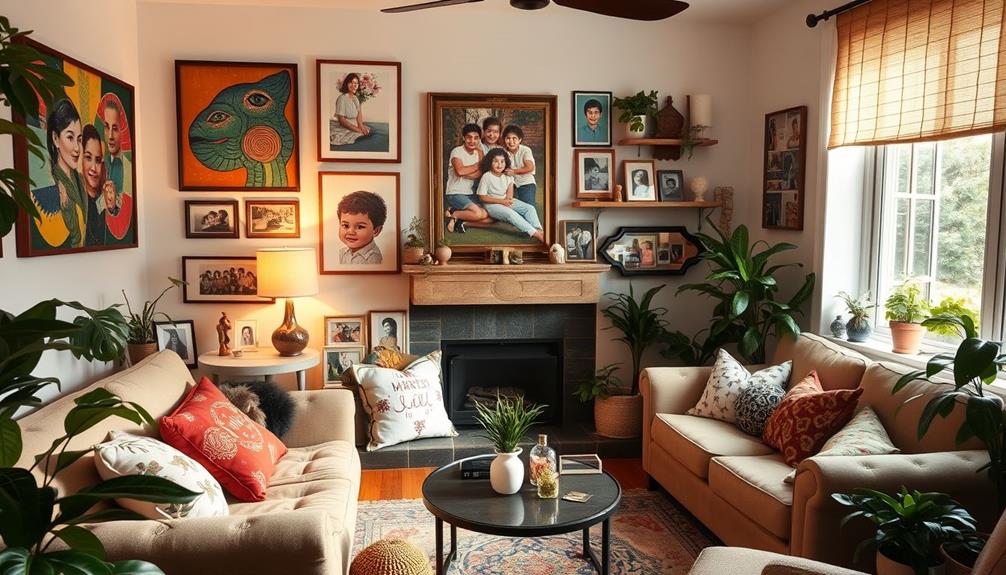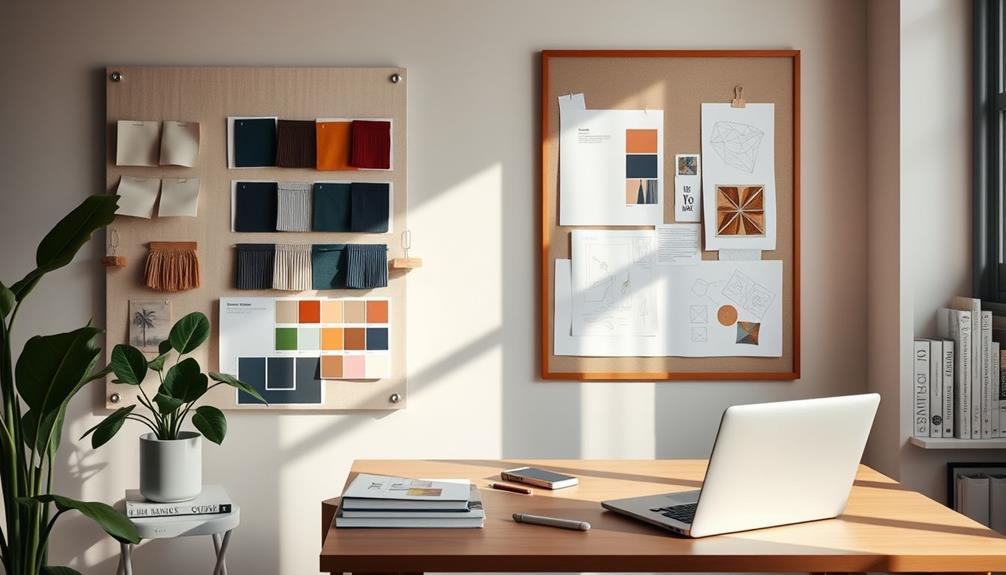To interior design your own house, start by establishing a budget. Categorize your expenditures and track costs meticulously. Next, create a mood board that showcases your desired style using colors and materials. Select key furniture pieces that prioritize quality and fit your space. Choose a cohesive color scheme that reflects the atmosphere you want in each room. Finally, add personal touches, like photos or souvenirs, to make the space truly yours. Each step builds on the last, helping you craft a harmonious design that feels both stylish and uniquely personal. There's plenty more to explore on this journey! If you’re specifically looking to enhance your living room design, consider investing in a comfortable and visually appealing sofa that serves as the focal point of the room. Incorporate versatile storage solutions, like coffee tables with extra compartments, to keep the space organized and clutter-free. Additionally, don’t be afraid to mix patterns and textures to add visual interest and depth to your living room design. These living room design tips will help you create a welcoming and functional space for relaxation and entertaining.
Key Takeaways
- Establish a budget by categorizing expenses and tracking costs, adding a contingency for unexpected expenses.
- Create a mood board with inspiration elements to visualize design choices and maintain focus throughout the process.
- Prioritize quality foundational furniture and consider multi-functional pieces to maximize space and enhance versatility.
- Choose a cohesive color scheme that reflects the desired mood, incorporating neutral tones for larger areas and vibrant accents in decor.
- Personalize your space with meaningful items, showcasing collections and artwork that reflect your unique style and experiences.
Establish Your Budget
Before diving into your interior design project, it's vital to establish a clear budget. Start by categorizing your expenditures into must-haves, nice-to-haves, and low-priority items. This will help you control overall project costs effectively.
Incorporate elements that reflect current trends in farmhouse decor, such as an emphasis on neutral color palettes, which can create a cohesive look throughout your home. Use a spreadsheet to track line items and cost estimates while adding an additional 10-20% contingency for unexpected expenses that may arise.
Next, assess the measurements of your space. Creating a layout helps you visualize how the design elements will fit together and guarantees you don't overspend on furniture that won't serve the intended function.
Prioritize foundational furniture purchases that align with your budget, focusing on quality and durability to reduce future replacement costs.
Obtaining at least three bids from contractors is also significant. This allows you to compare costs and quality, guaranteeing you make informed decisions without breaking the bank.
Develop a Mood Board

Creating a mood board is essential for visualizing your design goals and ensuring everything aligns with your style.
Start by selecting inspiration elements like images, color swatches, and materials that resonate with you.
This collection will serve as a guide, helping you refine your choices and maintain focus throughout the design process.
Purpose of Mood Board
A mood board is essential for bringing your design vision to life, serving as a visual guide that captures the essence of the space you want to create. By compiling images, color swatches, and fabric samples, you clarify your design process and communicate your desired atmosphere effectively.
Creating a mood board not only showcases your personal style but also helps you analyze recurring themes and design inspiration. It acts as a reference point that can prevent costly mistakes by guiding your purchasing decisions, ensuring all elements, including paint color and textures, harmonize.
Here's a quick overview of the purpose of a mood board:
| Purpose | Description |
|---|---|
| Visual Representation | Captures your design style and atmosphere |
| Analysis | Identifies themes and styles in your choices |
| Intentionality | Encourages emotional connections in your design |
Using digital tools like Canva or Pinterest makes assembling your mood board easy, allowing you to share and collaborate with others. In this way, your mood board becomes an integral part of your interior design journey, ensuring that your vision is realized in a cohesive and meaningful way.
Selecting Inspiration Elements
With your mood board set up, it's time to gather inspiration elements that truly reflect your vision for the space. Start by collecting images, fabric swatches, and color samples that resonate with your desired aesthetic. This visual representation will guide you through the design process, helping you make your space feel cohesive and intentional.
Consider exploring Island Getaways for unique color palettes and textures that evoke a sense of adventure and relaxation.
To create a strong foundation, consider incorporating a springboard object. This could be a favorite piece of art or a cherished textile that embodies your style. Here are a few ideas to inspire you:
- A vibrant painting that sparks joy and sets the color palette
- A textured fabric swatch that brings warmth and comfort
- A unique decorative item that adds character and personality
Utilize online platforms like Pinterest or Canva to assemble your mood board digitally. This allows for easy adjustments and an expansive collection of inspiration.
As you analyze recurring styles and themes, you'll refine your design direction. Keep your budget in mind, ensuring the elements you choose aren't only visually appealing but also feasible for your project's financial constraints. This approach will help you create a space that truly reflects your vision.
Select Key Furniture Pieces

Selecting key furniture pieces is essential for establishing a cohesive and functional interior design. Start by prioritizing quality and durability, especially for foundational items like sofas and dining tables. These pieces should withstand daily use while enhancing your overall aesthetic.
Additionally, consider incorporating multi-functional furniture, which can help maximize space, particularly in smaller living areas. Next, consider the scale and proportion of the furniture in relation to your room dimensions. You want to guarantee that each piece fits comfortably, avoiding overcrowding and maintaining a smooth flow throughout the space.
Opt for neutral colors for your foundational furniture. This choice adds versatility, enabling you to update decor and accessories easily without needing to replace significant pieces.
Additionally, think about incorporating multifunctional furniture, such as ottomans with hidden storage or sofa beds. These options maximize space and adapt to your changing needs, particularly in smaller living areas.
Choose Paint and Colors

Once you've chosen key furniture pieces, it's time to think about how paint and colors can enhance your space. Start by selecting a general color scheme that reflects the desired feel or mood of each room. This gives you the flexibility to choose specific hues later.
Consider incorporating suggestions from interior design experts, such as using a mix of warm and cool tones to create balance in your environment, or exploring ideas for high-quality home printers that can help you print color swatches for better visualization.
Consider the following to guide your choices:
- Soft beige walls that create a calming atmosphere.
- Bold teal accents that invite energy and creativity.
- Warm gray trims that add sophistication and warmth.
Use paint samples to test colors on your walls, observing them at different times of the day to see how natural light affects their appearance. Research current design trends and look for inspiration on platforms like Pinterest.
Remember, the undertones of your paint colors are vital, as subtle variations can greatly impact your space's overall feel. Testing these colors on a white background clarifies their true essence.
Incorporate neutral colors for larger areas and foundational furniture, allowing vibrant accents in smaller decor items. This approach will make a space versatile and adaptable for years to come.
Create a Cohesive Design

A cohesive design transforms your house into a harmonious home, where each room flows seamlessly into the next. Start by establishing a clear vision for your interior, identifying a central theme or style that resonates with your personal preferences. This vision will guide your design choices throughout the process.
Consider incorporating stylish wall clocks to enhance time management visually and add a decorative touch.
Create a mood board to visualize how different colors, textures, and furniture styles will work together. This will help guarantee consistency in your design.
Utilize a cohesive color palette across all rooms, selecting complementary shades that enhance the overall flow and create a harmonious atmosphere.
When choosing furniture, select foundational pieces that share similar design aesthetics and materials to unify the look. Incorporate versatile accessories that can adapt to changing trends without disrupting your theme.
Regularly assess all design elements for coherence and balance. Make sure each room contributes to a unified narrative that reflects your personal style while enhancing the functionality of the space.
Incorporate Personal Touches

Incorporating personal touches into your home design can transform a generic space into a true reflection of who you are. By integrating elements that resonate with your experiences, you create a unique narrative that breathes life into your surroundings.
Start by showcasing your personal collections—think travel souvenirs or cherished family heirlooms. Use these items as decorative elements that tell your story, much like how Aboriginal art features distinctive styles that convey deep cultural meanings.
Consider adding:
- Personal sketches or artwork that adorn your walls, giving your space a custom touch.
- Cohesive gallery walls filled with meaningful photographs, allowing you to share your life's journey visually.
- Dedicated spaces for hobbies, like a bookshelf filled with favorite reads or a gardening nook, crafting a functional environment that mirrors your passions.
Choose colors and materials that evoke your emotional experiences, ensuring every aspect contributes to a space that feels authentically yours.
This thoughtful approach not only enhances the aesthetics of your home but also cultivates an inviting atmosphere that welcomes you and your guests, making your space truly one-of-a-kind.
Conclusion
Now that you've mapped out your interior design journey, think of your home as a canvas waiting for your artistic flair. Just like a painter blends colors to create a masterpiece, you'll weave together your budget, mood board, and personal touches to craft a space that reflects who you are. Remember, designing your home isn't just about aesthetics; it's about creating a sanctuary that feels uniquely yours. So grab that brush—your masterpiece awaits!









